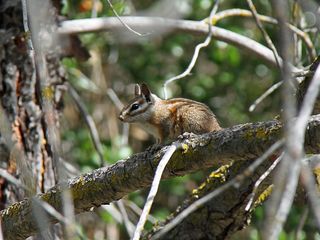Lori Paul is a Chaney Trail neighborhood resident and keeper of many environmental flames here in Altadena. She recently gave us permission to reprint an article about living with in the same neighborhood as wildlife that we thought was worth sharing.
by Lori Paul
It is amazing how many unscrupulous, big name exterminator companies are out there (and trappers, by the way, who "control" coyotes for places like the Huntington Gardens) who know they have built-in job security because what they do sets up a constant cycle of "re-infestation" that requires subsequent poisoning, more traps, etc.

Pictured: Merriam's chipmunk, from Wikipedia Commons.
As long as people live on the edge of wild areas, there will be an endless stream of young animals looking for new territory and places to survive who will move in after dominant individuals are poisoned or trapped in a location that provides these species with food, water, or safe shelter. Rounds of poisoning, or "spraying for spiders and ants," or gassing gophers, etc. costs property owners incredible sums of money and causes incredible suffering and losses of wildlife, including raptors, foxes, ringtail cats, bobcats and other predators or "non-target" prey (like beneficial lizards, frogs and toads, small birds, etc.) that eat toxic baits or die slowly on those horrific sticky boards.
Also, consider what happens when people pick up the popular, oh-so-convenient pesticide-laden "special" grass seed combos that are advertised to eliminate all insects in your new lawn. Folks wonder why we no longer see robins and other insect-eating songbirds, or butterflies, dragonflies, and beneficial insects like praying mantises, or even small bats... It's because those poison-infused products indiscriminately kill all insects that are the foundation of the food chain for wildlife.
The toxicity in theses insecticides either poisons, or starves, higher life forms like robins that ordinarily eat cutworms, grasshoppers, and other pests... loss of natural bird and other small predators further imbalances the truncated "nature" present in urban lawns and gardens... that loss, in turn, requires more and stronger poisons to control the "super cutworms" or slugs or other pests. This becomes a costly, losing battle that only benefits companies like Ortho and Monsanto!
We have an English flower garden and fruit trees on our property. We avoid all poisons and allow all the insects and vertebrate native species to thrive around our home, including birds, bats, lizards, western toads, Merriam's chipmunks, ladybugs and yes, even spiders, gophers, wood rats, scorpions, snakes (rattlesnakes come and go), and more.
Not only do we enjoy observing these wild species, our roses, irises, and other flowers; our citrus, apples, figs and other fruit and herbs all look terrific. The small amount of damage caused by grasshoppers, cutworms, slugs, or other insects is not really noticeable and is well controlled by the balance between natural predators and prey. Even the introduced European snails get munched by the skunks and possums who pass through the garden at night.
Such "nativescaping" is the economical and environmentally responsible way to have a lovely garden. Watching birds and wildlife also provides entertainment.
For those who have long relied on poisons, gopher traps, and chemically-infused lawns, it will take some time to restore the balance, but the results are well worth the effort and easy on one's pocketbook during these tough economic times. Use the money formerly spent on pest spraying services and trappers to buy some fruit trees and native plants or to install a small pond for birds, wildlife and for the beauty water adds to your garden. The results will be well worth the time and investment. The following website is one of many that can help anyone who wants to bring nature back into their garden do so at little cost:



